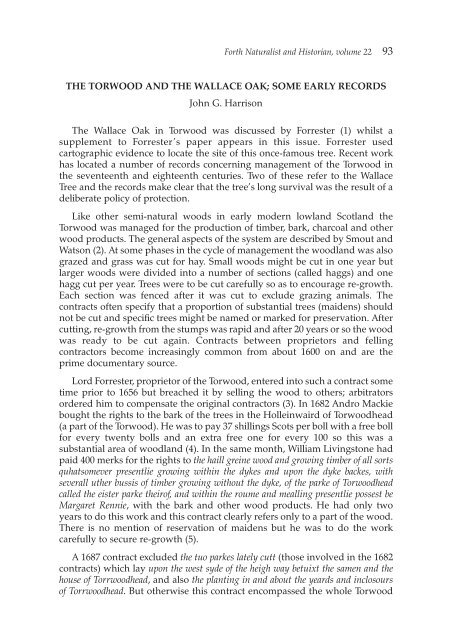the Forth Naturalist Historian - Forth Naturalist and Historian ...
the Forth Naturalist Historian - Forth Naturalist and Historian ...
the Forth Naturalist Historian - Forth Naturalist and Historian ...
Create successful ePaper yourself
Turn your PDF publications into a flip-book with our unique Google optimized e-Paper software.
<strong>Forth</strong> <strong>Naturalist</strong> <strong>and</strong> <strong>Historian</strong>, volume 22 93<br />
THE TORWOOD AND THE WALLACE OAK; SOME EARLY RECORDS<br />
John G. Harrison<br />
The Wallace Oak in Torwood was discussed by Forrester (1) whilst a<br />
supplement to Forrester’s paper appears in this issue. Forrester used<br />
cartographic evidence to locate <strong>the</strong> site of this once-famous tree. Recent work<br />
has located a number of records concerning management of <strong>the</strong> Torwood in<br />
<strong>the</strong> seventeenth <strong>and</strong> eighteenth centuries. Two of <strong>the</strong>se refer to <strong>the</strong> Wallace<br />
Tree <strong>and</strong> <strong>the</strong> records make clear that <strong>the</strong> tree’s long survival was <strong>the</strong> result of a<br />
deliberate policy of protection.<br />
Like o<strong>the</strong>r semi-natural woods in early modern lowl<strong>and</strong> Scotl<strong>and</strong> <strong>the</strong><br />
Torwood was managed for <strong>the</strong> production of timber, bark, charcoal <strong>and</strong> o<strong>the</strong>r<br />
wood products. The general aspects of <strong>the</strong> system are described by Smout <strong>and</strong><br />
Watson (2). At some phases in <strong>the</strong> cycle of management <strong>the</strong> woodl<strong>and</strong> was also<br />
grazed <strong>and</strong> grass was cut for hay. Small woods might be cut in one year but<br />
larger woods were divided into a number of sections (called haggs) <strong>and</strong> one<br />
hagg cut per year. Trees were to be cut carefully so as to encourage re-growth.<br />
Each section was fenced after it was cut to exclude grazing animals. The<br />
contracts often specify that a proportion of substantial trees (maidens) should<br />
not be cut <strong>and</strong> specific trees might be named or marked for preservation. After<br />
cutting, re-growth from <strong>the</strong> stumps was rapid <strong>and</strong> after 20 years or so <strong>the</strong> wood<br />
was ready to be cut again. Contracts between proprietors <strong>and</strong> felling<br />
contractors become increasingly common from about 1600 on <strong>and</strong> are <strong>the</strong><br />
prime documentary source.<br />
Lord Forrester, proprietor of <strong>the</strong> Torwood, entered into such a contract some<br />
time prior to 1656 but breached it by selling <strong>the</strong> wood to o<strong>the</strong>rs; arbitrators<br />
ordered him to compensate <strong>the</strong> original contractors (3). In 1682 Andro Mackie<br />
bought <strong>the</strong> rights to <strong>the</strong> bark of <strong>the</strong> trees in <strong>the</strong> Holleinwaird of Torwoodhead<br />
(a part of <strong>the</strong> Torwood). He was to pay 37 shillings Scots per boll with a free boll<br />
for every twenty bolls <strong>and</strong> an extra free one for every 100 so this was a<br />
substantial area of woodl<strong>and</strong> (4). In <strong>the</strong> same month, William Livingstone had<br />
paid 400 merks for <strong>the</strong> rights to <strong>the</strong> haill greine wood <strong>and</strong> growing timber of all sorts<br />
quhatsomever presentlie growing within <strong>the</strong> dykes <strong>and</strong> upon <strong>the</strong> dyke backes, with<br />
severall u<strong>the</strong>r bussis of timber growing without <strong>the</strong> dyke, of <strong>the</strong> parke of Torwoodhead<br />
called <strong>the</strong> eister parke <strong>the</strong>irof, <strong>and</strong> within <strong>the</strong> roume <strong>and</strong> mealling presentlie possest be<br />
Margaret Rennie, with <strong>the</strong> bark <strong>and</strong> o<strong>the</strong>r wood products. He had only two<br />
years to do this work <strong>and</strong> this contract clearly refers only to a part of <strong>the</strong> wood.<br />
There is no mention of reservation of maidens but he was to do <strong>the</strong> work<br />
carefully to secure re-growth (5).<br />
A 1687 contract excluded <strong>the</strong> tuo parkes lately cutt (those involved in <strong>the</strong> 1682<br />
contracts) which lay upon <strong>the</strong> west syde of <strong>the</strong> heigh way betuixt <strong>the</strong> samen <strong>and</strong> <strong>the</strong><br />
house of Torrwoodhead, <strong>and</strong> also <strong>the</strong> planting in <strong>and</strong> about <strong>the</strong> yeards <strong>and</strong> inclosours<br />
of Torrwoodhead. But o<strong>the</strong>rwise this contract encompassed <strong>the</strong> whole Torwood



